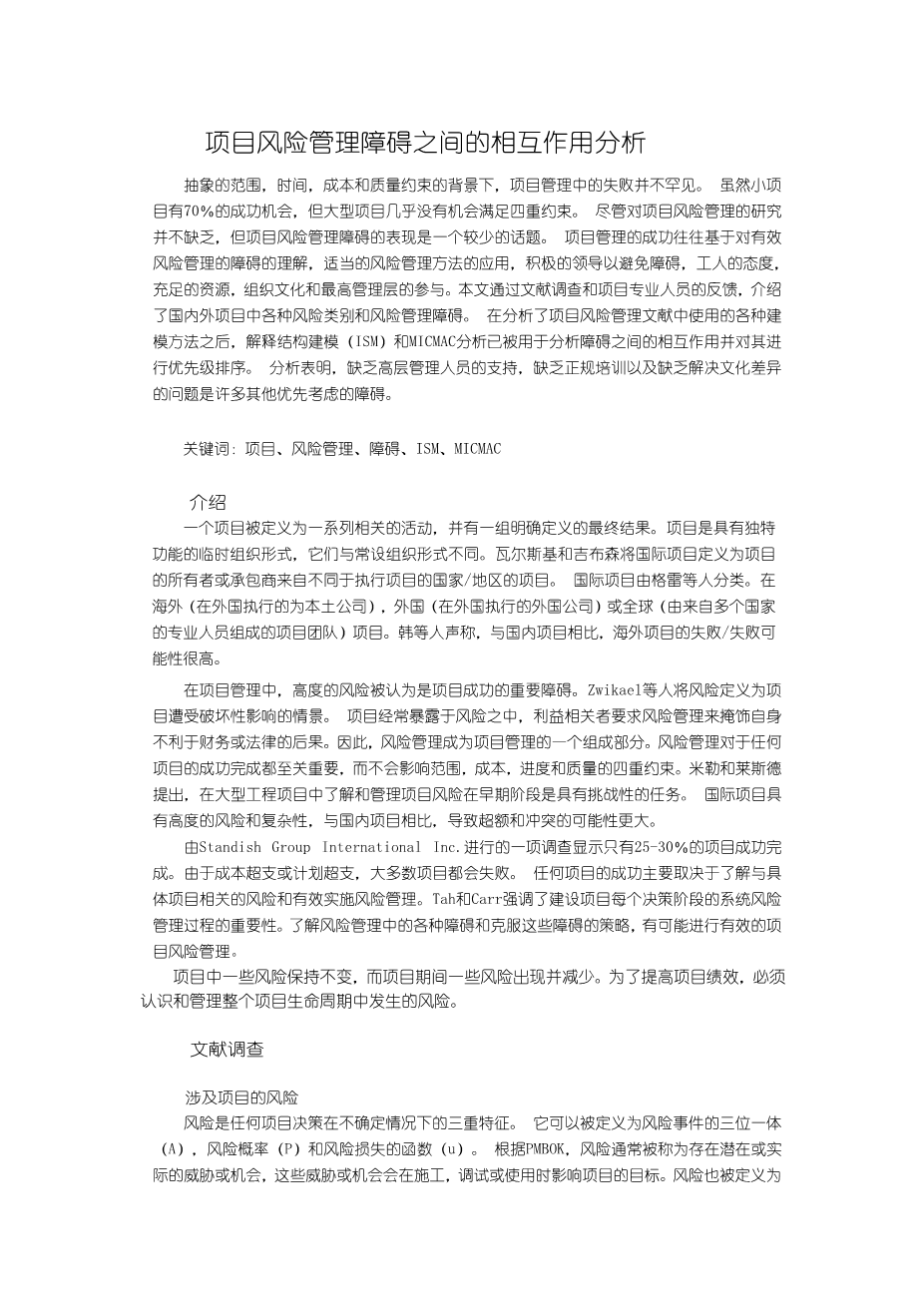Analysis of the interaction between project risk management barriers
In the context of abstract scope, time, cost, and quality constraints, failures in project management are not uncommon. While small projects have a 70% chance of success, large projects have little chance of meeting the quadruple constraint. Although there is no lack of research on project risk management, the presentation of project risk management barriers is a rare topic. Success in project management is often based on an understanding of the barriers to effective risk management, the application of appropriate risk management methods, active leadership to avoid barriers, worker attitudes, adequate resources, organizational culture, and the involvement of top management. This paper introduces various risk categories and risk management barriers in domestic and foreign projects through literature surveys and feedback from project professionals. After analyzing the various modeling approaches used in the project risk management literature, explanatory structural modeling (ISM) and MICMAC analysis have been used to analyze and prioritize the interactions between barriers. The analysis showed that a lack of support from senior management, a lack of formal training and a lack of addressing cultural differences were many other priority barriers.
Key words: project, risk management, obstacle, ISM, MICMAC
introduce
A project is defined as a set of related activities with a well-defined set of end results.Projects are temporary forms of organization with unique functions, which are different from permanent forms of organization.Varski and Gibson define an international project as one in which the owner or contractor comes from a different country/region than the one executing the project. International projects are classified by gray et al.Projects performed overseas (local companies in foreign countries), foreign (foreign companies in foreign countries) or global (project teams of professionals from multiple countries).Han et al claim that overseas projects are more likely to fail/fail than domestic projects.
In project management, high risk is considered an important obstacle to project success.Zwikael et al. defined risk as a scenario in which the project is adversely affected. Projects are often exposed to risk and stakeholders require risk management to disguise their adverse financial or legal consequences.Therefore, risk management becomes an integral part of project management.Risk management is critical to the successful completion of any project without affecting the four major constraints of scope, cost, schedule, and quality.Miller and leist argue that understanding and managing project risk in the early stages of a large engineering project is a challenging task. International projects are highly risky and complex, and are more likely to lead to excess and conflict than domestic projects.
A survey by Standish Group International inc. found that only 25-30% of projects are completed successfully.Most projects fail because of cost overruns or planned overruns. The success of any project depends primarily on an understanding of the risks associated with a particular project and the effective implementation of risk management.Tah and Carr stress the importance of a systematic risk management process at each decision stage of a construction project.Understanding the barriers to risk management and strategies for overcoming them will make effective project risk management possible.
Some risks in the project remain the same, while some risks appear and decrease during the project.To improve project performance, risks that occur throughout the project lifecycle must be recognized and managed.
The literature survey
Risks involved in the project
Risk is the triple feature of any project decision under uncertainty. It can be defined as the triad of risk events (A), risk probability (P), and risk loss (u). According to the PMBOK, risks are often referred to as the existence of potential or actual threats or opportunities that affect the objectives of the project during construction, debugging, or use.Risk is also defined as an uncertain event or condition that, if it occurs, has a positive or negative impact on the projects objectives.Jannadi and Almishari define risk as potential damage that may affect people or property.Sato and Hirao define risk as the possibility of a critical situation in which the activity fails to provide the mandatory results required for the projects objectives, nor does it provide a direct alternative.Ward and chapman put forward the term uncertainty rather than risk to indicate that it may be a threat or an opportunity.
The unpredictable nature of projects makes them riskier than day-to-day business activities.All project lifecycles consist of a series of phases and activities, from the origin to completion, each of which always involves a degree of risk.The organizational and technical complexity of the project creates significant risks.Managing risk at each stage is important to improving project success.
As Latham stated, risk can be managed, minimized, Shared, transferred, or accepted, but not ignored.As illustrated by Sarewitz et al., the two components of risk are event risk and outcome risk. Event risk is the occurrence of a specific event, and risk is a specific outcome.
Risk management is one of the important project management processes.In general, risk management is an important, continuous and iterative process use for identifying potential sources of risk at different stages of a project during development.Aven notes that the concept of risk and risk assessment has a long history, but risk assessment and management became a scientific field 30-40 years ago.Most research on risk management focuses on risk identification and analysis.Apply the information generated through proj
剩余内容已隐藏,支付完成后下载完整资料


英语译文共 8 页,剩余内容已隐藏,支付完成后下载完整资料
资料编号:[607767],资料为PDF文档或Word文档,PDF文档可免费转换为Word
您可能感兴趣的文章
- 饮用水微生物群:一个全面的时空研究,以监测巴黎供水系统的水质外文翻译资料
- 步进电机控制和摩擦模型对复杂机械系统精确定位的影响外文翻译资料
- 具有温湿度控制的开式阴极PEM燃料电池性能的提升外文翻译资料
- 警报定时系统对驾驶员行为的影响:调查驾驶员信任的差异以及根据警报定时对警报的响应外文翻译资料
- 门禁系统的零知识认证解决方案外文翻译资料
- 车辆废气及室外环境中悬浮微粒中有机磷的含量—-个案研究外文翻译资料
- ZigBee协议对城市风力涡轮机的无线监控: 支持应用软件和传感器模块外文翻译资料
- ZigBee系统在医疗保健中提供位置信息和传感器数据传输的方案外文翻译资料
- 基于PLC的模糊控制器在污水处理系统中的应用外文翻译资料
- 光伏并联最大功率点跟踪系统独立应用程序外文翻译资料



